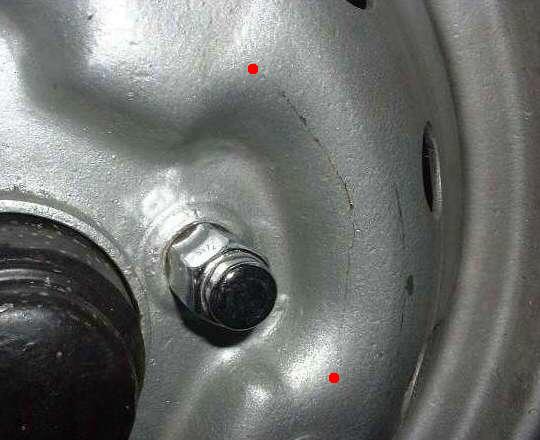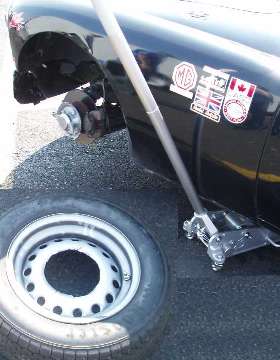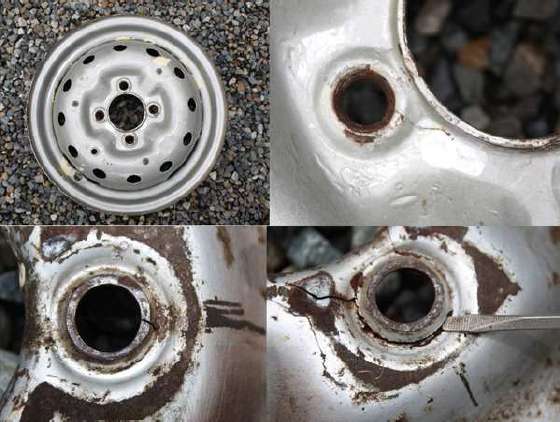The MGA With An Attitude
STRESS CRACKS in Steel Wheels -- WL-101
Time to inspect your stock MGA steel wheels and check for cracks. The Stock MGA wheels were spec'd and built in a time when bias ply nylon cord tires were the norm, radial tires were just struggling to make inroads into the world, and no one had hardly dreamed of what we know today as modern race tires. The MGA steel wheel is (by today's standard) somewhat thin and flexible. With good modern tires and some spirited driving it is possible for one of these wheels to develop a stress crack.

The crack here (between the two red dots) is just to the right of the lug nut, on the crown of the wheel, just inside of the hubcap ring. This will be the most common location for a stress crack, plus or minus about 1/2 inch. I have broken seven steel wheels in recent years with six of them having this type of crack. One of them was a much different catastrophic failure, but that one was induced by a broken wheel stud, The crack you see here has the metal slightly depressed just to the left of the crack (closer to center of wheel), and slightly raised just to the right (something like an earthquake vertical fault line). If you run your finger over this crack from left to right it first gives the impression of a crack in the paint, until you may notice a little blood running from the small cut in your finger. That crack can have a very sharp raised edge.
I have been warning folks of the folly of running these wheels with race tires, as most of my steel wheel failures have occurred while autocrossing on race tires. This one however is the second wheel I have had fail in this manner while driving exclusively on normal radial street tires. Apparently 40 years of somewhat spirited sports car driving can accumulate significant fatigue in the metal. Just how many times does a wheel go around in 300,000 miles anyway? Something like 240,000,000 revolutions.
Food for thought. Please check your stamped steel wheels for cracks.
Addendum September 12, 2006: - - - (click for larger picture)
Here's an example of a Twin Cam pin drive steel wheel which failed under racing conditions. The picture (and the mishap) is contributed by Ralph Zbarsky in Canada. The crack would have started in the same location shown in the picture above.

From Ralph: "YM3-721 decided to ventilate a wheel, throwing the wheel rim, most of the steel center portion (and the tire) rapidly through the fender and on down the track! The remnant of the centre remained securely held on to the hub! This occurred on a high-speed turn, and fortunately the driver, sensing impending doom, was able to get off track to the grass before real disaster. Other cars on track took evasive action.
Tires are Hoosier bias ply, track surface is excellent, air temperature was about 30 degrees C. I had all my wheels powder coated a few years ago, because I was forever cleaning and repainting them. On my race cars, the wheels get bashed on and off quite a few times. It is hard to imagine the forces involved to cause this failure, especially when you see much heavier cars, with lots of horsepower, blasting around the track with no problems."
Addendum March 13, 2012:
Photo by John Backman in Washington, USA. This one shows cracks around the bolt holes. It is a 1600 type wheel with the thicker center disc. Perhaps that does not translate into crack resistance at the embossed bolt holes. Fifty years of spirited driving can do some nasty things to road wheels.

|